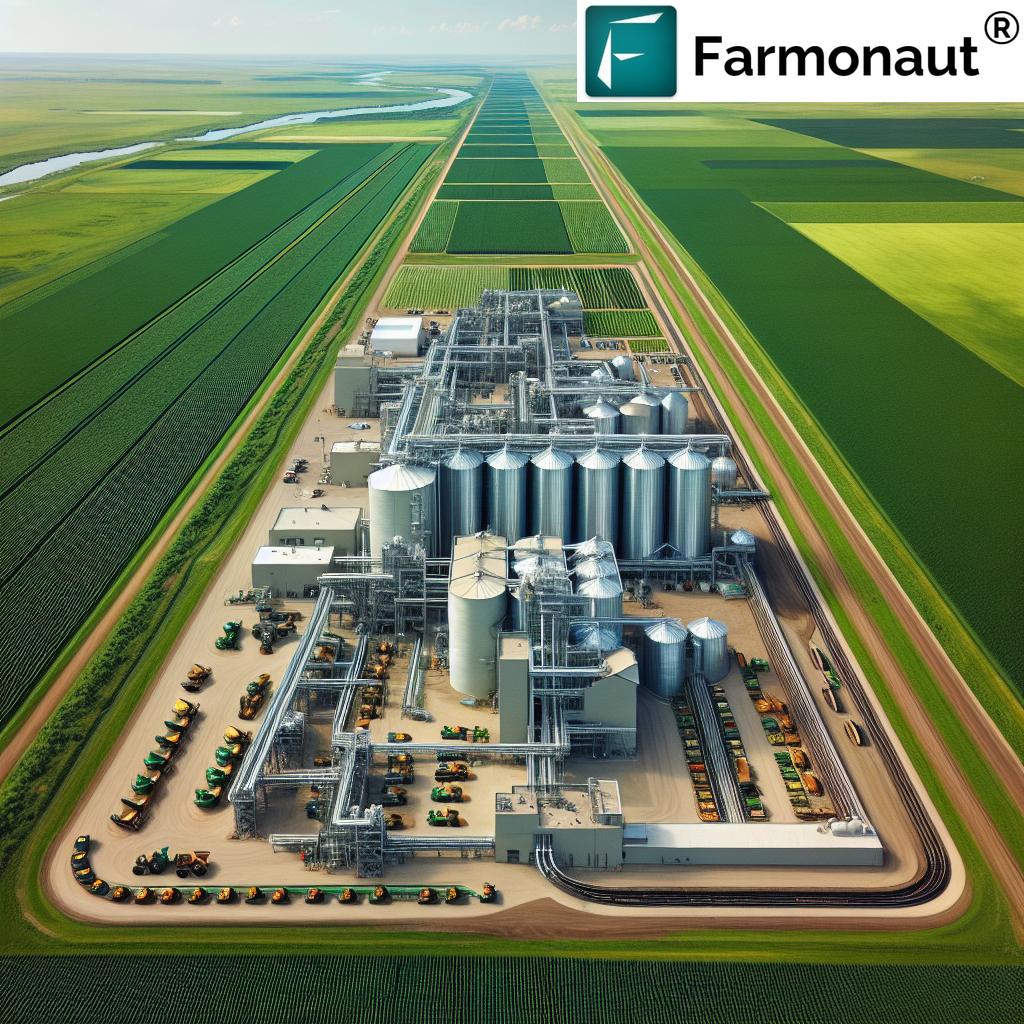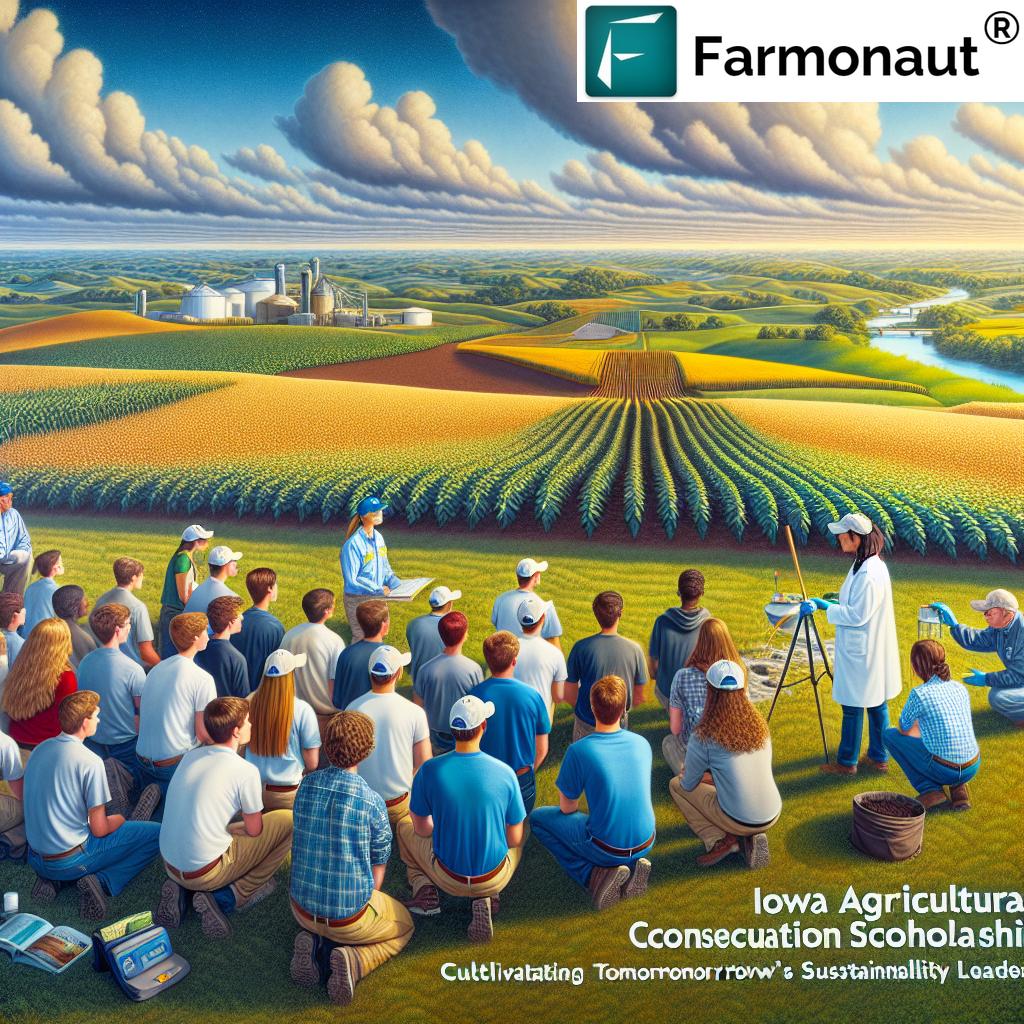Table of Contents
- Summary: Minnesota Agriculture in 2025—Sustaining Growth Through Innovation and Resilience
- Introduction: Agriculture of Minnesota—A National Leader in 2025
- Diverse Crop Production & Agricultural Economy in Minnesota
- Livestock Industry: Sustaining Growth with Innovation
- Technological Innovation & Precision Agriculture Minnesota 2025
- How Farmonaut’s Satellite Technology Empowers Minnesota’s Agriculture
- Sustainability & Climate Resilience in Minnesota’s Agriculture
- Market Trends, Consumer Preferences, & Policy Shaping Minnesota Agriculture
- Minnesota Agriculture 2025: Key Trends & Estimated Impact (Comparison Table)
- Minnesota’s Agricultural Future: What Lies Beyond 2025?
- FAQ: Minnesota Agriculture 2025 Innovation & Trends
- Farmonaut: Satellite Solutions to Elevate Minnesota Farming
- Conclusion: Agriculture of Minnesota 2025—Rooted in Innovation
“Minnesota farms in 2025 use 40% more precision agriculture tools, boosting crop yields and resource efficiency.”
Agriculture of Minnesota: 2025 Trends & Innovation
Summary: Minnesota Agriculture in 2025—Sustaining Growth Through Innovation and Resilience
The agriculture of Minnesota continues to be a cornerstone of the state’s economy, identity, and community as we advance into 2025. With an emphasis on technological innovation, sustainable farming, precision agriculture, and climate adaptation, Minnesota remains a national leader—setting standards for crop production, livestock innovation, and responsible stewardship of resources.
This article explores the evolving landscape of agriculture Minnesota, analyzing how trends in sustainability, technology, resilience, and policy are not just supporting the region’s diverse production but shaping the future of its rural communities and economic prosperity. From robust corn and soybean outputs to sustainable livestock management and weather-smart farming, discover the opportunities and challenges that define the agriculture of Minnesota in 2025 and beyond.
Introduction: Agriculture of Minnesota—A National Leader in 2025
Minnesota stands tall as a beacon of agricultural excellence, recognized nationally for its diverse crop production, resilient industry, and innovative adaptation to change. In 2025, the agriculture minnesota sector remains pivotal—driven by heritage, culture, and relentless improvement in farming practices and technology.
- Economy: Minnesota agriculture contributes over $88 billion annually and supports more than 400,000 jobs statewide.
- Diversity: The state ranks among the top U.S. producers of corn, soybeans, wheat, sugar beets, potatoes, and livestock.
- Resilience & Adaptation: Minnesota’s agricultural community demonstrates unmatched resilience and sustainability, even as it navigates weather, climate, and market pressures.
- Innovation: Precision agriculture tools, satellite technology, AI, and data-driven models are revolutionizing productivity and reshaping how farms operate and thrive.
As we look ahead, the agriculture minnesota landscape is marked by a continuous commitment to innovation, efficiency, and sustainability, ensuring a future where farming remains at the heart of Minnesota’s identity and economic vitality.
Diverse Crop Production & Agricultural Economy in Minnesota
Top Producers: Corn, Soybeans, Sugar Beets, Wheat, Potatoes & More
The agriculture of Minnesota is characterized by diversity— from robust feed grains such as corn and soybeans to specialty and emerging crops like sweet corn, pumpkins, and berries. This region consistently ranks among the nation’s top producers, driven by a combination of ideal soil, efficient farming practices, and strategic investments.
- Corn & Soybeans: These crops dominate acreage in 2025, driven by ongoing strong demand for animal feed, biofuels, export markets, and local food systems.
- Wheat, Sugar Beets & Potatoes: Minnesota remains a key player in these markets, with increased productivity due to precision technologies and sustainable practices.
- Specialty Crops: The rise of consumer markets for local, regional, and organic products has increased investment in berries, pumpkins, sweet corn, and other high-value crops—supporting farm diversity and community economies.
In 2025, agricultural production is bolstered by continuous investment in rural infrastructure. Upgrades to transportation, on-farm processing, and broadband connectivity directly support market access, jobs, and growth statewide.
Minnesota Agriculture’s Economic Impact
- Contribution: Over $88 billion annually boosted by agricultural outputs, processing, and trade.
- Jobs: More than 400,000 jobs statewide, directly and indirectly linked to farming and agriculture-related industries.
- Investment: Continuous investment in infrastructure and emerging technologies underpins the region’s growth and economic resilience.
For farmers and stakeholders, these trends mean adapting to consumer preferences, leveraging precision tools, and adopting resilient practices that lower risk and boost returns.
Livestock Industry: Sustaining Growth with Innovation
The livestock sector is integral to the agriculture of Minnesota. The state remains a national leader in hogs, dairy, and beef cattle production, thanks to robust genetics, advanced nutrition, and animal health technologies.
- Hogs: Innovative health management and feed models have increased animal welfare and productivity.
- Dairy: Sustainability programs and precision feeding support higher milk yields while reducing environmental impact.
- Beef Cattle: Genetic improvement and rotational grazing increase resilience and lower disease pressure.
Transparency & Food Quality
Consumers are increasingly focused on the origin, welfare, and quality of their food. Minnesota livestock producers emphasize transparency and sustainable practices:
- Enhanced traceability enables validated claims about animal health, sustainable feed, and low-carbon footprints.
- Farmers adopt blockchain and satellite data platforms (like Farmonaut Product Traceability) for secure animal and product tracking, ensuring confidence for end consumers and regulators.
The evolving livestock industry demonstrates Minnesota’s commitment to innovation-driven, transparent, and ethical food production systems.
Technological Innovation & Precision Agriculture Minnesota 2025
Precision Agriculture: Data, Efficiency, and Sustainability
In 2025, technological innovation is at the heart of the agriculture of Minnesota. Precision agriculture tools, digital platforms, and real-time monitoring are helping farmers optimize yields and reduce resource waste.
- GPS-guided Equipment & Smart Sensors: Enable targeted application of water, fertilizers, and pesticides, resulting in higher yields with lower input costs.
- Drones & Satellite Imagery: Monitor crop health, detect disease outbreaks, and assess soil moisture. These interventions allow rapid, precise, and efficient resource allocation.
- Data Analytics & Machine Learning: Using predictive models, farmers can forecast weather, crop growth, and risks (from pests or diseases), enabling better planning and reduced environmental impact.
- Genomics & Biotech: Support the development and deployment of drought-tolerant and disease-resistant crops, essential for adapting to Minnesota’s changing climate patterns.
These investments in innovation and precision contribute directly to the state’s resilience, efficiency, and sustainable crop production efforts.
How Technology Improves Outcomes for Minnesota Farmers
The transition to digital and satellite-driven agriculture models (like those offered by Farmonaut—see below) supports:
- Improved Resource Allocation: Data-backed decisions reduce resource waste, lower expenses, and protect the environment.
- Early Risk Detection: Satellite imagery and real-time reports identify crop stress or anomalies early for swift action.
- Automated Workflows: Save labor and reduce operational errors, particularly valuable as labor markets tighten.
- Continued Productivity in Changing Conditions: From heat resilience to improved disease resistance, technology keeps Minnesota on the leading edge of global agriculture trends.
Farmonaut’s online platform enables Minnesota’s large-scale farms and cooperatives to monitor crop health, schedule interventions, and manage their agri-business with AI-driven insights—reducing input costs and supporting sustainability.
How Farmonaut’s Satellite Technology Empowers Minnesota’s Agriculture
We at Farmonaut are proud to empower the agriculture of Minnesota with advanced satellite technology, AI-powered insights, and blockchain solutions—designed to make data-driven farming affordable, accessible, and impactful for every stakeholder.
Farmonaut Satellite Monitoring: Supporting Precision, Sustainability, and Growth
- Real-Time Monitoring: Our large-scale farm management platform uses up-to-date satellite images to track vegetation health (NDVI), soil moisture, and field variability for timely action—critical for both row crops (corn, soybeans, wheat) and specialty crops.
- AI Advisory via Jeevn: Our AI-driven Jeevn system provides Minnesota farmers with tailored weather forecasts, crop growth alerts, and risk predictions—delivered via web, mobile app, or API.
- Blockchain Traceability: Farmonaut’s blockchain-backed traceability tools help Minnesota producers validate the journey of their products, ensuring origin, quality, and integrity—vital as consumers and regulators demand greater transparency.
- Environmental Impact Monitoring: We offer carbon footprint monitoring and actionable resource-use analytics, making it easier to align with Minnesota’s sustainability and climate goals.
- API & Integration: For developers, agtech startups, and institutions—our robust Satellite API and Developer Docs enable custom solutions that bring the power of satellite data to any operation—large or small.
- Accessible Apps & Subscription Model: Our apps (Android, iOS, Web) cater to individual farmers, agronomists, cooperatives, agribusinesses, and researchers across Minnesota—with modular pricing and subscription options for every need.
- Fintech Integration: Crop loan and insurance providers can use Farmonaut’s satellite verification to streamline farmer financing, cut risks, and build trust across Minnesota’s evolving agricultural sector.
Ready to see Minnesota’s fields in a new light? Explore Farmonaut Solutions!
Farmonaut’s Fleet Management enables Minnesota’s agri-businesses to track equipment, optimize logistics, and boost operational efficiency—vital for today’s technology-driven farming landscape.
Sustainability & Climate Resilience in Minnesota’s Agriculture
Sustainability and climate adaptation are at the core of Minnesota’s modern agriculture. In 2025, farmers, policymakers, and agribusinesses work together to balance economic viability with environmental health—ensuring agriculture Minnesota remains resilient and responsible as climate and weather patterns shift.
- Cover Cropping & Reduced Tillage: Aimed at improving soil health, these practices help conserve water, enhance carbon sequestration, reduce erosion, and cut greenhouse gas emissions.
- Rotational Grazing & Smart Feeding: Livestock operations rotate herds and manage feed precisely, reducing methane emissions and bolstering pasture resilience.
- Renewable Energy: Solar panels, wind turbines, and on-farm bioenergy support renewable power generation and contribute to statewide energy goals.
- Water Management & Irrigation Efficiency: Sensors, models, and on-farm monitoring systems drive smarter irrigation, minimizing overuse and protecting local waterways.
- Integrated Pest Management: Data-driven approaches and biotech reduce dependence on chemical pesticides, safeguarding pollinators and long-term ecosystem health.
“Over 60% of Minnesota’s agricultural land adopts sustainable practices, reducing environmental impact significantly by 2025.”
Through both tradition and forward-thinking, Minnesota’s farmers are committed to environmental stewardship, water conservation, and sustainable productivity—ensuring that rural landscapes thrive for future generations.
Market Trends, Consumer Preferences, & Policy Shaping Minnesota Agriculture
The agriculture of minnesota is continually shaped by evolving global markets, consumer expectations, and government policy. In 2025, several key trends are influencing the state’s agricultural future:
- Local, Organic, and Sustainable Foods in Demand: Consumer demand for local, organic, and transparently grown foods is on the rise. More Minnesota farms pursue organic certification, expanded direct-to-consumer models (CSAs, farmers’ markets), and blockchain-based traceability to capture premium markets.
- Government Programs and Support: Federal and state programs provide funding and technical support for infrastructure, sustainability projects, rural broadband, and innovation adoption, ensuring resources flow to the farms that need them most.
- Global Trade & Export: Market resilience is maintained by a healthy mix of export crops (notably corn and soybeans) and expanding high-value local markets.
- Changing Climate Policies: With the climate agenda moving forward, Minnesota producers increasingly embrace carbon farming and renewable initiatives—both to meet regulations and tap into new revenue streams (see Farmonaut’s Carbon Footprinting Solution for practical farm-level tracking).
Impact on Minnesota Farmers & Communities
- Supports rural job creation, farm succession, and community well-being
- Fosters innovation and continuous improvement across the state’s farming sector
- Encourages direct engagement between farmers, consumers, and policymakers, driving future-positive outcomes
Minnesota Agriculture 2025: Key Trends & Estimated Impact
This table summarizes the top trends, practices, and innovations driving Minnesota’s agriculture sector in 2025—highlighting their technologies, sustainability benefits, and projected impact:
| Trend/Innovation | Description | Estimated 2025 Adoption Rate (%) | Technology Involved | Environmental Impact | Sustainability Benefits |
|---|---|---|---|---|---|
| Precision Farming | Site-specific management of inputs for optimal yields and minimal resource use | ~60% | GPS, IoT sensors, satellite imagery, data platforms | 20–30% reduction in fertilizer/water use | Cuts input waste, lowers emissions, boosts profitability |
| Regenerative Agriculture | Soil-building practices: cover crops, reduced tillage, diverse rotations | ~45% | Satellite crop monitoring, IoT, AI advisory | Significant increase in soil organic matter, carbon sequestration | Restores soil, enhances drought/flood resilience, improves water quality |
| Drought-Resilient Crops | Breeding/genomics for crops thriving under climate stress | ~35% | AI models, genomic tech, satellite assessment | Resilient yields despite weather extremes | Stability in production, lower crop loss risk |
| Automated Farm Machinery | Robotic tractors, planters, and harvesters with AI guidance | ~28% | AI, robotics, IoT-based remote control | Lower energy use, reduced compaction | Boosts labor efficiency, maintains productivity |
| Crop Health Monitoring (Satellite/Aerial) | Remote sensing for plant stress, disease, and pest alerting | ~72% | Satellites, drones, NDVI, AI analytics | Early problem detection minimizes losses | Promotes targeted interventions, reduces chemical use |
| Blockchain-Based Traceability | End-to-end digital record of produce for transparency and trust | ~38% | Blockchain, API integration, mobile app | Reduces fraud, supports sustainable claims | Builds consumer and regulator trust in Minnesota produce |
Minnesota’s Agricultural Future: What Lies Beyond 2025?
Looking to the future, the agriculture of minnesota stands at the exciting intersection of technology, tradition, and sustainability. As climate and markets continue to change, Minnesota’s rural backbone will rely on collaboration, data-driven adaptation, and environmental care:
- Innovation Remains Central: With continuous advances in satellite technology, AI, genetics, and automation, farms will become even more efficient, productive, and sustainable.
- Climate Resilience is Paramount: Expanding the use of drought- and disease-resistant varieties, water-saving methods, and renewable energy will further insulate agriculture from unpredictable weather.
- Sustainable Communities Thrive: Strong infrastructure enables job creation, healthy communities, and intergenerational farm succession—ensuring Minnesota’s agricultural legacy endures.
Continued investment, policy support, and technology-driven adaptation will help Minnesota maintain its national leadership in an era of ever-evolving agricultural demands.
Farmonaut: Satellite Solutions to Elevate Minnesota Farming
We offer flexible subscriptions for Minnesota farmers, agribusinesses, and communities—making satellite insights, AI advisory, and sustainability tools accessible for every need. Manage crop health, trace production, lower resource use, and meet climate goals with Farmonaut’s modular platform.
Farmonaut’s AI-driven advisory and satellite-based resources deliver measurable gains for Minnesota agriculture: from optimizing field operations to reducing carbon emissions and supporting truly sustainable food production. Discover more about large-scale farm management.
FAQ: Minnesota Agriculture 2025 Innovation & Trends
What are the top 2025 agriculture trends in Minnesota?
Major trends include increased adoption of precision agriculture tools, sustainable and regenerative farming practices, use of AI/data analytics, drought-resistant crops, blockchain traceability, and renewable energy on farms.
How does Farmonaut support Minnesota’s agriculture sector?
We support Minnesota farmers and agri-businesses by offering satellite-based crop monitoring, real-time AI advisory, carbon footprint tracking, and blockchain-based traceability—all via easy-to-use web, Android, iOS, and API tools.
What is the economic impact of agriculture in Minnesota in 2025?
Agriculture Minnesota contributes over $88 billion annually to the state’s economy and supports more than 400,000 jobs.
How are farmers in Minnesota addressing climate change?
Through a mix of sustainable practices—such as cover cropping, reduced tillage, smart irrigation, and renewable energy use—along with new technology (biotech, AI, satellite monitoring), Minnesota farmers are adapting to extreme weather and building climate resilience.
How can Minnesota farms access affordable satellite and data solutions?
Farmonaut offers affordable subscriptions and a modular platform for Minnesota agriculture.
Check out our large-scale management solution or API for custom projects.
Where can developers find documentation for Farmonaut’s agricultural API?
Our full developer docs are available here—enabling integration of real-time satellite and weather data into Minnesota agri-tech solutions.
Conclusion: Agriculture of Minnesota 2025—Rooted in Innovation
The agriculture of minnesota in 2025 is a powerful example of how resilience, tradition, and relentless innovation drive a sector forward.
Embracing advanced technologies, sustainable practices, and data-driven decisions, Minnesota’s agricultural producers are safeguarding their legacy and securing future prosperity for generations to come.
With climate realities and market shifts continually reshaping the landscape, investments in smart tools, science-backed practices, and rural development ensure that Minnesota remains a national leader—combining heritage with a progressive outlook to meet tomorrow’s food, energy, and environmental needs.
We at Farmonaut are honored to play a role in this ongoing journey—providing affordable satellite-based insights, supporting sustainable growth, and helping every Minnesota farmer, agri-business, and community thrive in a data-driven world.













